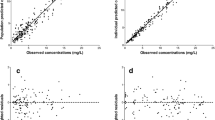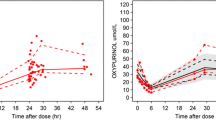Summary
The pharmacokinetic and pharmacodynamic profiles of atenolol were studied in adult male rabbits on continuous peritoneal dialysis given 3 mg/kg i.v. before and during renal failure. The average terminal elimination half-life for the drug was 2.5 h calculated from blood, dialysate or urinary data. This value increased about nine times in anuric conditions. Although atenolol was eliminated in the peritoneal fluid, the amount excreted was relatively low both in normal conditions and renal failure, respectively 0.6 and 7% of the administered dose. The pharmacokinetic model was extended by an “effect compartment”, which has no influence on the predetermined mass of drug in the body, to analyse the relationship between heart rate fall and changes in atenolol blood concentrations. After drug administration, heart rate fell rapidly about 90 beats in both states. The mean equilibration half-time of atenolol effect and blood concentrations was 0.7 and 1.5 h in normal and pathological states, respectively. The mean blood concentration required to produce 50% of heart rate fall was similar in both conditions, 0.23 mg/1. The nine-fold decrease of atenolol elimination in anuria was in good agreement with the increase in duration of the drug’s effect, and was suitably described by the “effect model”.
Similar content being viewed by others
References
Oreopoulos D.G., Robson M., Faller B., Ogilvie R., Rapoport A. and de Veber G.A. (1979): Continuous ambulatory peritoneal dialysis A new era in the treatment of chronic renal failure. Clin. Nephrol.,11, 125–128.
Dettli L. (1983): Drug dosage in renal disease in Handbook of Clinical Pharmacokinetics M. Gibaldi and L. Prescott, eds. ADIS, New York, pp. 261–276.
Gambertoglio J.C. (1984): Effects of renal disease: Altered pharmacokinetics in Pharmacokinetic Basis for Drug Treatment L.Z. Benet, N. Massoud and J.G. Gambertoglio eds., Raven Press, New York, pp. 149–171.
Gibson T.P. (1980): Influence of renal disease on pharmacokinetics in Applied Pharmacokinetics. Principles of Therapeutic Drug Monitoring W.E. Evans, J.J. Schentag and W.J. Jusko eds., Applied Therapeutics, S. Francisco, pp. 32–56.
Traîna G.L., Celardo A., Arboix M. and Bonati M. (1986): Experimental model for pharmacokinetic studies during continuous peritoneal dialysis in the rabbit. J. Pharmacol. Methods,15, 133–142.
Young M.A., Nolph K.D., Dutton S. and Prowant B.F. (1984): Anti-hypertensive drug requirements in continuous ambulatory peritoneal dialysis. Peritoneal Dialysis Bulletin,4, 85–88.
Reeves P.R., McAinsh J., Mcintosh D.A.D. and Winrow M.J. (1978): Metabolism of atenolol in man. Xenobiotica,8, 313–320.
Reeves P.R., Barnfield D.J., Longshaw S., Mcintosh D.A.D. and Winrow MJ. (1978): Disposition and metabolism of atenolol in animals. Xenobiotica,8, 305–311.
Sassard J., Pozet N., McAinsh J., Legheand J. and Zech P. (1977): Pharmacokinetics of atenolol in patients with renal impairment. Eur. J. Clin. Pharmacol.,12, 175–180.
Salahudeen A.K., Wilkinson R., McAinsh J. and Bateman D.N. (1984): Atenolol pharmacokinetics in patients on continuous ambulatory peritoneal dialysis. Br. J. Clin. Pharmacol.,18, 457–460.
Vas S. (1981): Microbiological aspects of peritonitis. Peritoneal Dialysis Bulletin,1 suppl., S11-S14.
Traina G.L. and Bonati M., (1985): Pharmacokinetics of theobromine and its metabolites in rabbits. J. Pharmacokin. Biopharm.,13, 41–53.
Nishikawa K., Morrison A. and Needleman P. (1977): Exaggerated prostaglandin biosynthesis and its influence on renal resistance in the isolated hydronephrotic rabbit kidney. J. Clin. Invest.,59, 1143–1150.
Flynn M.A. (1984): Nutritional problems in continuous ambulatory, peritoneal dialysis. Peritoneal Dialysis Bull.,4 suppl., S142-S146.
Yee Y.G., Rubin P. and Blaschke T.F. (1979): Atenolol determination by high-performance liquid chromatography and fluorescence detection. J. Chromatogr.171, 357–362.
Sacchi Landriani G., Guardabasso V. and Rocchetti M. (1983): NL-FIT: A microcomputer program for nonlinear fitting. Comput. Programs Biomed.16, 35–42.
Rocchetti M. and Recchia M. (1982): SPBS: Statistical programs for biological sciences. Minicomputer software for applying routine biostatistical methods. Comput. Programs Biomed.,14, 7–20.
Benet L.Z. and Galeazzi R.L. (1979): Noncomportamental determination of the steady-state volume of distribution. J. Pharm. Sci.,68, 1071–1074.
Gibaldi M. and Perrier D. (1982): Pharmacokinetics 2nd. ed., Dekker, New York.
Sheiner L.B., Stanski D.R., Vozeh S., Miller A.D. and Ham J. (1979): Simultaneous modeling of pharmacokinetics and pharmacodynamics: Application to d-tubocurarine. Clin. Pharmacol. Ther.,25, 358–371.
Whiting B., Holford N.H.G. and Sheiner L.B. (1980): Quantitative analysis of the disopyramide concentration-effect relationship. Br. J. Clin. Pharmacol.,9, 67–75.
Holford N.H.G. and Sheiner L.B. (1981): Understanding the dose-effect relationship: Clinical application of pharmacokinetic-pharmacodynamic models. Clin. Pharmacokinet,6, 429–453.
Kozma C, Macklin W., Cummins L.M. and Mauer R. (1974): Anatomy physiology and biochemistry of the rabbit in The Biology of the Laboratory Rabbit S.H. Weisbroth, R.E. Flatt and A.L. Kraus eds. Academic Press, New York, pp. 49–72.
Gotloib L., Crassweller P., Rodella H., Oreopoulos D.G., Zellerman G., Ogilvie R., Husdan H., Brandes L. and Vas S. (1982): Experimental model for studies of continuous peritoneal dialysis in uremic rabbits. Nephron,31, 254–259.
Zappacosta A.R., Caro J. and Erslev A. (1982): Normalization of hematocrit in patients with end-stage renal disease on continuous ambulatory peritoneal dialysis. The role of erythropoietin. Am. J. Med.,72, 53–57.
Hefti J.E., Blumberg A. and Marti H.R. (1983): Red cell survival and red cell enzymes in patients on continuous peritoneal dialysis (CAPD). Clin. Nephrol.19, 232–235.
McAinsh J., Holmes B.F., Smith S., Hood H. and Warren D. (1980): Atenolol kinetics in renal failure. Clin. Pharmacol. Ther.,28, 302–309.
Bonati M. and Tognoni G. (1984): Has clinical pharmacology lost its way? Lancet,1, 556–558.
Author information
Authors and Affiliations
Rights and permissions
About this article
Cite this article
Celardo, A., Traina, G.L., Arboix, M. et al. Pharmacokinetic and pharmacodynamic modelling of atenolol in rabbits maintained on continuous peritoneal dialysis. European Journal of Drug Metabolism and Pharmacokinetics 12, 41–48 (1987). https://doi.org/10.1007/BF03189860
Received:
Issue Date:
DOI: https://doi.org/10.1007/BF03189860




